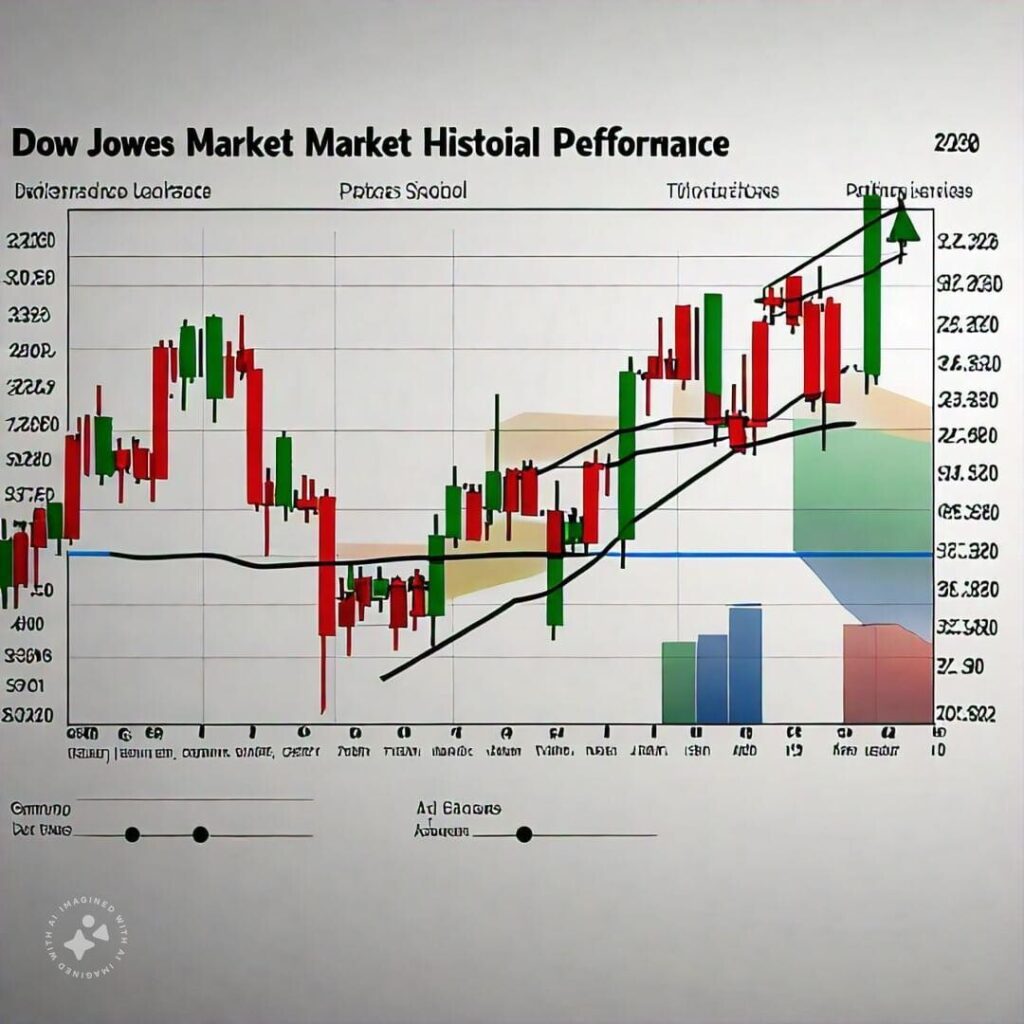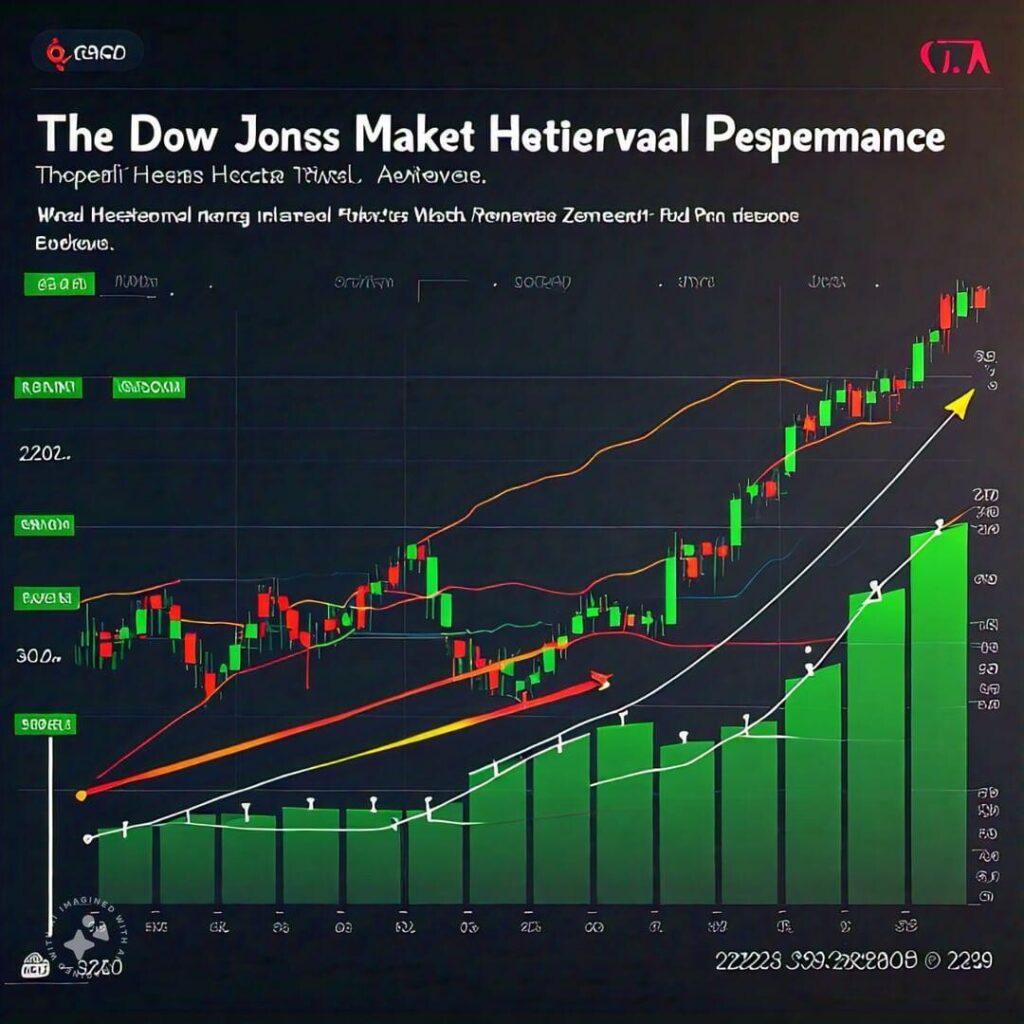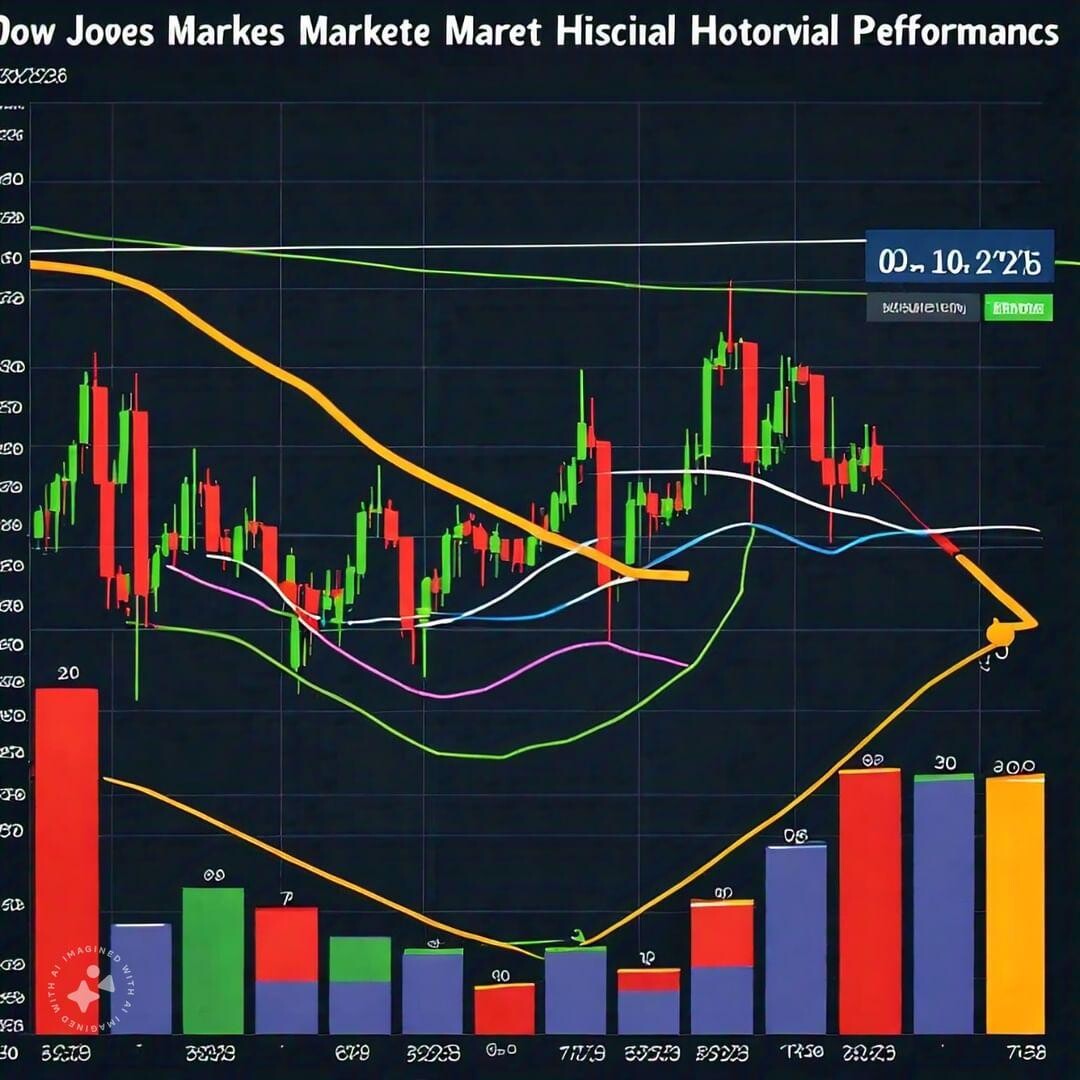The Dow Jones Industrial Average is a key indicator of the U.S. economy’s health. It has been tracking the economy for over a century1. Since its start in 1886, it has seen huge highs and lows, showing the stock market’s ever-changing nature1.
In its nearly 140 years, the Dow Jones has shown incredible returns. It hit a high of 81.66% in 1915 and a low of -52.67% in 19311.
The index has hit many important points, like a drop of -33.84% in 2008 and a rise of 66.69% in 19331. It has also seen ups and downs in recent years, like a 25.32% gain in 2003 and a 16.76% loss in 20021. Over time, the Dow Jones has grown from 12 to 30 companies, showing the U.S. economy’s evolution1.
Origins and Evolution of the Dow Jones Industrial Average
The Dow Jones Industrial Average (DJIA) has a long and fascinating history. It started in the late 19th century2. Charles Dow, the co-founder of Dow Jones & Company, introduced it on May 26, 18962. The first version, the Dow Jones Railroad Average, had 11 stocks in 18842.
Charles Dow’s Original Composition
Charles Dow’s first DJIA included 12 companies from the industrial sector. The average started at 40.94 points2. These companies were leaders in energy, railroads, and food at the time3.
Transformation from 12 to 30 Companies
The DJIA has changed a lot over the years2. By 1916, it had 20 stocks, and by 1928, it had 302. General Electric is the only original stock still in the DJIA2.
Significance in Global Markets
The Dow Jones Industrial Average is a key indicator of the U.S. stock market’s performance3. By October 18, 2024, it had 30 companies with a total market cap of US$12.0 trillion3. It’s a price-weighted index, with a factor of about 0.152 as of April 20243. You can invest in it through index funds, derivatives, and leveraged ETFs3.

The Dow Jones Industrial Average, with its long history and major American companies, is a key benchmark in global finance32.
Key Milestones in Dow Jones Market Historical Performance
The Dow Jones Industrial Average (DJIA) has seen many important moments in its history. These moments show the ups and downs of the market, the economy, and Wall Street4. It started in 1896 with 12 companies and now tracks 30 big firms4.
The 1929 crash was a big event, with the DJIA falling by 17.17%5. But, after World War II, the index soared by 26.65% in 19455. The 1987 crash was tough, but the DJIA still had a 2.26% return5. The dot-com bubble burst in 2000, causing a 6.17% drop5. The 2008 financial crisis was the worst, with a 33.84% fall5.
Recently, the DJIA has hit new records. It went over 15,000 in 20134 and 20,000 in 20174. On May 16, 2024, it hit an all-time high of 40,051.056. These achievements show the Dow’s ability to grow over time, even through tough times4.
Even though the DJIA doesn’t always beat the S&P 5004, it’s still a key guide for investors. It shows the health of the U.S. economy4. As the market and economy change, the Dow Jones remains a vital sign of the country’s economic health4.
Record-Breaking Years and Notable Bull Markets
The Dow Jones Industrial Average (DJIA) has seen some amazing years. In 1915, it jumped by 81.66%7. Then, in 1933, it soared by 66.69%7. The mid-1990s were also strong, with 1995’s 33.45% gain7.
Throughout its history, the DJIA has had many bull markets. These include the 1920s, 1950s-1960s, 1980s-1990s, and 2009-20198. Since 1957, the S&P 500 has grown over 65,000%8. We see long growth periods followed by sharp drops, like the 2009-2020 bull run7.
Highest Annual Returns (1915-2024)
| Year | Annual Return (%) |
|---|---|
| 1915 | 81.66% |
| 1933 | 66.69% |
| 1995 | 33.45% |
Significant Bull Market Periods
- 1920s
- 1950s-1960s
- 1980s-1990s
- 2009-2019
Analysis of Growth Patterns
The Dow Jones Industrial Average often grows for years and then drops sharply7. The 2009-2020 bull run was long and steady, despite ups and downs7. This growth has made the S&P 500 over 65,000% since 19578.
“Bull markets have shown strong performance, with an average gain of 41.8% in the first year following the previous bear market bottom.”8
It looks like the current bull market could last a long time. History shows these markets usually last about five years and give the S&P 500 over 169% return8.
Major Market Crashes and Recovery Periods
The Dow Jones Industrial Average (DJIA) has faced many market crashes and economic downturns. Each crash had its own impact and recovery time. The 1929 Great Depression was especially harsh, with the DJIA falling by 17.17% in 1929, then by 33.77% in 1930, and 52.67% in 19319. It took 25 years to recover from this crash, showing how severe it was9.
The 1987 crash, known as “Black Monday,” saw the DJIA drop by 22.6% in one day, the biggest drop in U.S. history10. But, the market bounced back in just a year, ending 1987 with a 2.26% gain10. The dot-com bubble burst and the 2008 financial crisis also caused big drops, with the DJIA losing 33.84% in 200810.
The COVID-19 pandemic led to a quick market crash in 2020. The DJIA and S&P 500 saw their biggest single-day drops on March 16, 202010. Yet, the markets quickly recovered, reaching their pre-pandemic levels in just five months9.
Despite the severity of market crashes, the Dow Jones has shown it can recover. Recovery times usually last one to three years9. This resilience is a sign of the U.S. financial markets’ strength and ability to adapt.

| Market Crash | Year | DJIA Decline | Recovery Period |
|---|---|---|---|
| Great Depression | 1929-1931 | -17.17% (1929), -33.77% (1930), -52.67% (1931) | 25 years |
| Black Monday | 1987 | -22.6% | 1 year |
| Dot-com Bubble Burst | 2000-2002 | Cumulative 3-year decline | 2-3 years |
| Financial Crisis | 2008 | -33.84% | 2-3 years |
| COVID-19 Pandemic | 2020 | Largest single-day point decline | 5 months |
“The stock market is a device for transferring money from the impatient to the patient.”
– Warren Buffett
The Dow Jones Industrial Average shows the U.S. financial markets’ resilience. Even with big crashes and recessions, the DJIA has always bounced back. This shows the American economy’s strength and adaptability.
Modern Era Performance (2000-2024)
The Dow Jones Industrial Average (DJIA) has shown its strength in the digital age. It has faced market ups and downs but kept going strong11. Since 2024 started, the US Stock Market Index has gone up by 20.06%11.
Despite global events and new tech, the DJIA remains key in the digital economy.
Digital Age Impact
The Dow Jones has changed to include more tech companies. The digital age has brought big changes. Now, companies like Apple11, Nvidia11, Microsoft11, Amazon11, Meta11, and Alphabet11 are big parts of it. These companies drive innovation and shape the market.
Post-2008 Recovery
After the 2008 crisis, the DJIA bounced back strongly. It went from 6,547.05 in 2009 to 29,000 by 201911. This shows the index’s ability to bounce back and the strength of the American economy.
Recent Market Trends
The Dow Jones has shown it can handle tough times, like the COVID-19 pandemic. In 2020, it closed at 30,606.4811. By 2023, it was at 37,689.5411. These trends show the DJIA’s ability to adapt and its importance in the digital economy.
| Company | Day Change | Year Change |
|---|---|---|
| Apple | -1.69% | 25.46% |
| Nvidia | 1.36% | 210.99% |
| Microsoft | 0.68% | 17.76% |
| Amazon | 6.09% | 43.28% |
| Meta | -0.29% | 82.38% |
| Alphabet | -0.14% | 34.36% |
| Exxon Mobil | -1.58% | 5.34% |
| Verizon | -1.95% | 15.21% |
| PayPal | -2.88% | 40.14% |
| Lockheed Martin | -0.28% | 19.05% |
| Illinois Tool Works | 0.72% | 13.48% |
| Hilton Worldwide | 0.61% | 54.91% |
| General Motors | 0.31% | 76.91% |
| Charter Communications | 11.39% | -11.58% |
The table shows how different companies in the Dow Jones have done lately. It shows the impact of new tech on the index11.
The digital economy has changed the Dow Jones a lot. It has shown it can handle tough times. The DJIA is a key sign of the US economy’s health and the effect of new tech globally.
“The Dow Jones Industrial Average has consistently demonstrated its ability to navigate the complexities of the digital age, underscoring the resilience of the American economy.”
The Dow Jones has faced many challenges but has kept going strong. It shows the US digital economy’s strength and ability to adapt1112.
Analysis of Price-Weighted Index Mechanics
The Dow Jones Industrial Average (DJIA) stands out in the financial world. It uses a price-weighted method, where higher-priced stocks have more influence. This is different from the S&P 500, which is based on market capitalization13.
This unique method can cause big changes in the DJIA’s performance. Stock splits or changes in high-priced stocks can greatly affect it14.
Stock splits are a big deal for the DJIA. When a company splits its stock, the index’s divisor is adjusted. This keeps the index’s value the same14. But, it can make the index’s performance seem off, as the split stock’s weight goes down.
Also, changes in high-priced stocks in the DJIA can have a big impact14. The index adds up the prices of the 30 stocks and divides by a special divisor. Adding or removing a high-priced stock can change the index’s value a lot, even if the market hasn’t changed much.
The DJIA’s unique price-weighted method has sparked debate among experts and investors13. It’s important to understand how the DJIA is calculated and what it means for the financial world.
Economic Indicators and Their Impact on DJIA
The Dow Jones Industrial Average (DJIA) closely follows key economic indicators15. Changes in interest rates by the Federal Reserve can significantly affect the index. Lower rates usually help stock prices rise15. GDP growth also positively impacts the DJIA, especially during strong economic times16.
However, the link between inflation and the DJIA is complex. Rising prices can increase the index’s nominal value. Yet, they can also reduce real returns over time16.
Interest Rate Correlations
The Federal Reserve’s interest rate decisions directly influence the DJIA15. Lower interest rates stimulate the economy and boost spending, raising stock prices16. On the other hand, rate hikes can slow growth and increase borrowing costs, affecting the DJIA negatively16.
GDP Relationship
The DJIA performs well during strong economic growth, as seen in GDP16. High GDP growth means higher profits and investor confidence, driving up stock prices16. Economic downturns, however, lead to DJIA declines, as it reflects the U.S. economy’s health16.
Inflation Effects
Inflation’s impact on the DJIA is complex16. Rising prices can increase the index’s nominal value. Yet, they can also reduce real returns over time16. High inflation can lower consumer power, affecting corporate earnings and stock market performance16. However, certain sectors like commodities or financials might do better in inflationary times, helping offset DJIA losses16.
| Economic Indicator | Relationship with DJIA |
|---|---|
| Interest Rates | Inverse correlation – lower rates generally boost stock prices |
| GDP Growth | Positive correlation – strong economic growth typically correlates with higher index performance |
| Inflation | Complex – can initially boost nominal values but may erode real returns over time |
In summary, the DJIA is closely linked to economic indicators like interest rates, GDP, and inflation. Understanding these connections helps investors make better decisions1516.
Blue Chip Companies’ Influence on Index Movement
The Dow Jones Industrial Average (DJIA) tracks 30 blue-chip companies. These companies cover a wide range of the U.S. economy17. They are leaders in their sectors, greatly affecting the index’s movement18.
The DJIA has changed over time. It now includes more tech, finance, and growth companies18. This change shows how the U.S. economy has evolved. The addition of these leaders has deeply impacted the index’s performance17.
The DJIA is based on stock prices. So, the prices of these big companies are key to the index’s movement17. Changes in their prices can greatly affect the index’s daily and long-term performance. This makes the DJIA a key indicator of the U.S. corporate health18.
FAQ
What is the Dow Jones Industrial Average?
The Dow Jones Industrial Average is a stock market index. It tracks the performance of 30 major American companies. It was started in 1896 and is very well-known.
How has the Dow Jones Industrial Average’s composition changed over time?
At first, it had 12 companies in energy, railroad, and food sectors. Now, it has 30 companies, showing changes in the U.S. economy.
What are some notable milestones in the Dow Jones Industrial Average’s history?
Important moments include the 1929 crash and the post-World War II boom. There was also the 1987 Black Monday and the 2000 dot-com bubble burst. The 2008 financial crisis was another big event.
The index has also seen long bull markets and record years.
What are some of the highest annual returns recorded by the Dow Jones Industrial Average?
The Dow Jones has seen big annual returns. For example, 81.66% in 1915, 66.69% in 1933, and 33.45% in 1995.
How has the Dow Jones Industrial Average performed during major market crashes?
The Dow Jones has seen big drops in crashes like the Great Depression and the 2008 crisis. But, it usually recovers in 1-3 years.
How has the digital age impacted the Dow Jones Industrial Average?
The digital age has changed the index. Tech companies now play a bigger role. This has changed how the index performs and its sector weights.
How does the Dow Jones Industrial Average’s price-weighted calculation method differ from other market indices?
The Dow Jones uses a price-weighted method. This means higher-priced stocks have more influence. This is different from the S&P 500’s market-cap-weighted method. Stock splits or changes in high-priced stocks can greatly affect the Dow Jones.
How do economic indicators influence the performance of the Dow Jones Industrial Average?
The Dow Jones is linked to economic indicators like interest rates and GDP growth. Changes in these can greatly affect the index.
How do the individual performances of the 30 blue-chip companies within the Dow Jones Industrial Average impact the overall index?
The 30 companies in the Dow Jones have a big impact on the index. Changes in these companies can change how the index performs.
